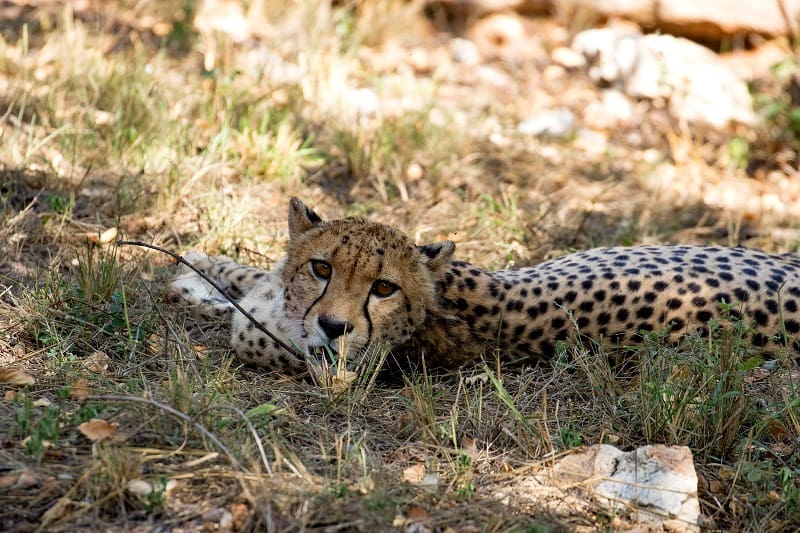[social_warfare]
Without the movement and noise of guests over the last few months, the wildlife of the Greater Makalali Private Nature Reserve had decided to move into Garonga Safari Camp.
It was a wise move as the structures provided refuge from the cold that had settled over the reserve. For the game animals, they also hoped perhaps that the human structures would deter any predators from joining them up at the camp. For the herd of impala that had taken up residence, their hopes were to be dashed by a certain spotted feline named Patsy.

Patsy was just two years old when she was released into the reserve in 2018. Her cheetah hunting skills were not yet fine-tuned at this stage and without having mastered the ‘death grip’, the prey she managed to bring down could break free and bolt away. This unfortunately led her hunting attempts to regularly result in a waste of energy and an empty stomach.
Even for lone adult cheetahs, the average hunting success rate remains quite low at around 40%. This makes being in the right spot at the right time to see a kill unfold rather rare. So, you can imagine the excitement of the Garonga guides as they watched Patsy not only effectively take down and kill an impala, but do so right on their doorstep, between the camp tents.
The Makalali’s cheetah population
Patsy currently shares the Greater Makalali Private Nature Reserve with five other cheetahs – two single roaming adult males, an older adult female and her two sub-adult male and female cubs. The Makalali is based in the savanna biome and has a variety of habitats within its borders, including the wide-open clearings of which the largest is the xinkankanka clearings (Shangaan for ‘cheetah clearings’) along with thick riverine and savanna woodland.

The cheetahs have adapted very well to living within the reserve and use the border fencing to aid them in their hunting efforts. Due to the success of the current cheetah population and the size of the Makalali, there is talk of introducing another two cheetahs in the near future to diversify the gene pool of the cheetah population within the reserve.
Cheetah reintroduction led by Garonga
Garonga Safari Co. is more than just its properties in the Big 5 reserve. The process of introducing the first cheetah into the reserve was driven and funded by Garonga owner, Bernie Smith. When the reserve asked him to name the cheetah, he took the opportunity to honour his late grandmother, Patsy. Garonga contributes to the anti-poaching activities throughout the reserve and funds from guests’ stays ensure that the land around the lodge is dedicated to the wildlife that has historically called it home. When Garonga’s safari team is not busy with guests, they are tasked with bush clearing and road maintenance tasks to minimize the impact of game drives on the reserve.

Garonga hosts children from local schools to give them the opportunity – often their first – of experiencing their natural heritage and inspire them to care for and protect their wildlife. By providing an internship to a graduate of the Wild Shots Outreach Programme, Garonga helps grow the interconnected community and conservation efforts within South Africa’s tourism industry. It also supports local charity, Rhino Revolution, with their work in the field and one of Garonga’s guides doubles as a Wild Pangolin Monitor and a Pangolin Monitoring Project Coordinator for the charity.
The importance of cheetah conservation
There are currently approximately only 6700 cheetahs in the wilderness across the world and they are listed as Endangered with Extinction on the IUCN Red List of Threatened Species. Best estimates are that cheetahs have disappeared from about 76% of their historic range in Africa. As the continent’s wild spaces continue to dwindle, there are four major challenges facing cheetahs, namely habitat loss, lack of genetic diversity, human and animal conflict, and competition with other predators.

That is why the survival of every individual cheetah like Patsy is hugely important for the future of the species. Through Patsy, her current counterparts and those still to come, there is real hope to secure the future of this spectacular big cat species. Knowing all of this, made watching her successfully take down the impala that much more special for the guides of Garonga.
Cover Image: The pair of sub-adult cubs that call the Makalali home © Sophie Barrett / Garonga
